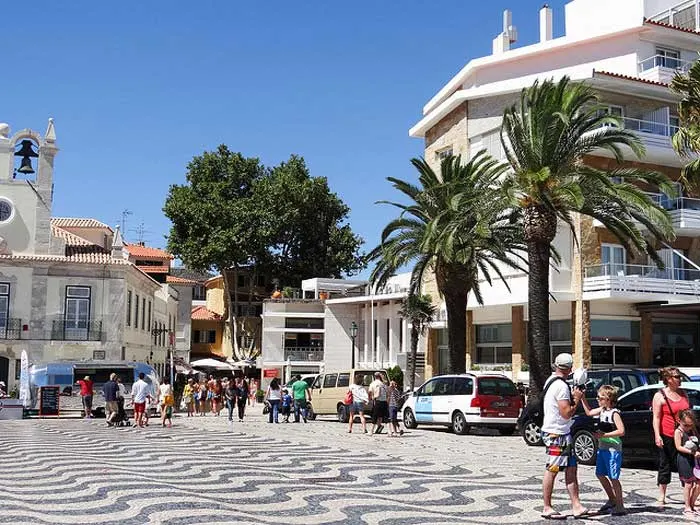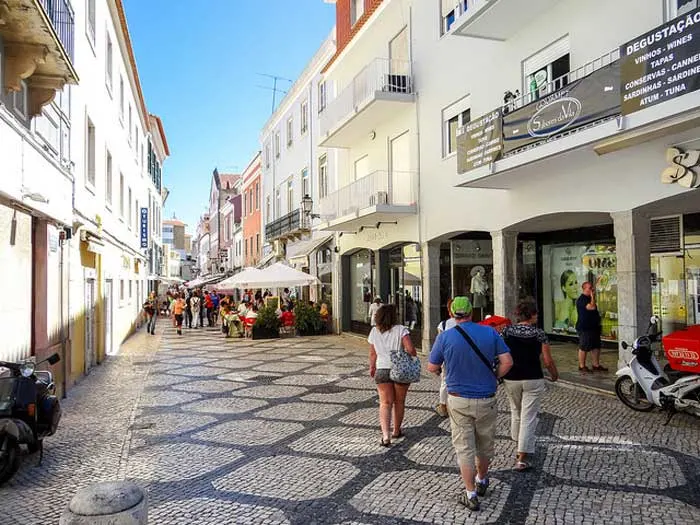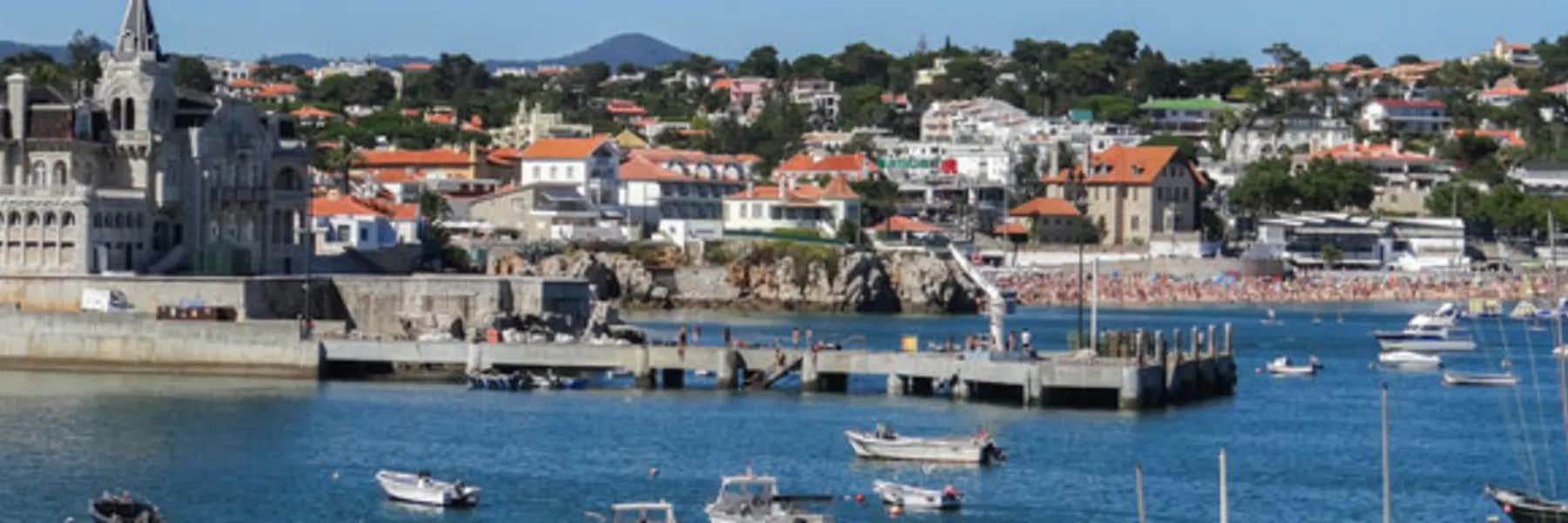Mention Portugal to your friends and you may get different reactions. Some might say the country is on their bucket list, while others may express concern about the cost of living in Europe. Others might not even be sure where it is.
One thing is certain: There’s no better place to begin discovering Portugal than in the cosmopolitan yet laidback village of Cascais, 20 miles west of Lisbon on the estuary of the River Tejo—also known by its former Roman name, the Tagus.
As you head west from Lisbon, you’ll encounter miles of sparkling shoreline, windswept dunes, and the pleasant beaches of Praia de Carcavelos, Praia da Conceição, Praia Rainha, and Praia Ribeira. You’ll also pass Estoril, the town inextricably intertwined with its neighbor, Cascais.
One unmistakable landmark to let you know you’ve arrived in Cascais is the Cidadela, a fortress built in the 15th century as defense against Spanish invaders. It took on a different role 400 years later when King Luis I of the ruling House of Braganza ordered the governor’s palace within its confines remodeled. He moored his yacht in the bay below, the fortress became the royal family’s summer residence, and Cascais was dubbed “the Portuguese Riviera.” (You, too can enjoy living like a monarch, because today the Cidadela is a five-star hotel, one of Portugal’s loveliest pousadas.)
Get Your Free Portugal Report Today!
Get Your Free Portugal Report Today!
Discover why we love a slower pace of life in Portugal and info on other European countries in our daily postcard e-letter. Simply enter your email address below and we’ll send you a FREE REPORT – Explore the Old World in Laidback Portugal.

By submitting your email address, you will receive a free subscription to IL Postcards, Overseas Dream Home, The Untourist Daily and special offers from International Living and our affiliates. You can unsubscribe at any time, and we encourage you to read more about our Privacy Policy.
Cascais has not forgotten its origins as a fishing village. Seasoned fisherman still leave from shore in the early morning, returning with their catch of sardines, crabs, mussels, robalo, dorado, and octopus. At lunchtime, the men share stories as they sit at long wooden tables on the dock, enjoying local wines and simmering fish soup ladled from huge stockpots.
It’s not only the arresting beauty of the bay that charms locals and visitors alike. Cascais is known for its manicured parks, shops offering traditional items like pottery and lace, and upscale clothing boutiques like Max Mara and Hugo Boss. A multitude of restaurants and cafés provide outdoor seating, and culture thrives here as well, at locations like the Paula Rego House of Stories and other museums.
Retire in Cascais

If you’ve had your fill of shoveling the snow from your driveway in winter or dealing with sweltering, humid summers, Cascais might be the answer for you. The town is blessed with a year-round moderate climate, with temperatures ranging from 55 F to 77 F. Golfing is nearby, and favorable sun and wind conditions make sailing, kite surfing, and windsurfing—in addition to traditional surfing—popular activities in this region whose economy hinges on tourism.
It’s easy to get around Cascais by car, although parking can be tricky at peak holiday times. But it’s a great walking zone (wear comfortable shoes for the cobbled streets and hills you’ll encounter) and there’s an ever-present taxi queue in the center of town next to the carousel.
To the north of Cascais is the wild and rugged surfing beach of Guincho, and further still is Sintra, famous for its pastel-painted castle of Pena, Moorish Castle, and Sintra-Cascais Natural Park. That’s where you can explore the majestic cliffs of Cabo da Roca, the westernmost point on the European continent.
When you want to head east, take the autostrada or the train (Linho do Cascais) to the Cais do Sodré station in Lisbon and visit its many museums, parks, and districts like Alfama—the oldest neighborhood in the capital. If you have an urge to travel further still, there’s a municipal airport nearby in Tires, and Lisbon Portela International Airport is just 45 minutes away.
These factors—pleasant climate, lovely natural surroundings, accessible culture, and more—combine to make Cascais an ideal choice for retirement.
Lifestyle in Cascais

Every day feels like a vacation day in Cascais. Sometimes it may seem that way because while sitting in a café at any point in time, in addition to English you may hear Spanish, German, French, Chinese, or Italian spoken. But it’s also because there are so many inexpensive, free, and fascinating things to do and see.
Start your day at Sacolinha, the famous bakery on the main street of Avenida 25 de Abril. Choose a pastry or something more substantial, like a tosta de fiambre e queijo. How can you go wrong with grilled ham and cheese?
Afterwards you might want to work off a few calories. A little more than a mile away is the dramatic seaside cliff formation of Boca do Inferno. When you’re done with your walk on the wild side, head back to the serenity of Portugal’s past preserved in a beautiful villa off the beaten path in the Museu Condes de Castro Guimarães.
On Wednesday and Saturdays, the market—aptly located on Rua Mercado—offers inexpensive clothing, handicrafts, and produce for sale in a festive atmosphere.
Grab a bite to eat and stroll the waterside promenade toward Estoril. Stop in the Casino Estoril, which was a hub of espionage intrigue during World War II. The presence of Allied and Axis officials in neutral Portugal inspired Ian Fleming, who frequented the casino, to create his legendary character James Bond.
You’ll find that Cascais and the surrounding area is the perfect blend of city hustle and bustle and the calming influence of brilliant blue waters and pristine beaches.
Get Your Free Portugal Report Today!
Get Your Free Portugal Report Today!
Discover why we love a slower pace of life in Portugal and info on other European countries in our daily postcard e-letter. Simply enter your email address below and we’ll send you a FREE REPORT – Explore the Old World in Laidback Portugal.

By submitting your email address, you will receive a free subscription to IL Postcards, Overseas Dream Home, The Untourist Daily and special offers from International Living and our affiliates. You can unsubscribe at any time, and we encourage you to read more about our Privacy Policy.
Cost of Living in Cascais

The village of Cascais is one of wealthiest municipalities in all of Portugal but that’s good news for you; it does not translate to “too expensive.” On the contrary, what it means is, the city is marvelously maintained. Streets are spotless. Red, yellow, and purple blooms burst from streetlamp baskets, and roundabouts are decorated with intricately designed flower arrangements.
Grocery shopping is convenient at the hipermercado Jumbo, where you’ll discover prices are lower than what you are used to at home. Here’s what you can expect in the way of expenses, based on a monthly average for two people:
| Item | U.S. $ |
|---|---|
| Rent (two-bedroom condo) | $1,475 |
| Utilities (Gas and electric) | $70 |
| Water | $30 |
| Internet/Telephone/Cell phones (2)/Cable (Package) | $80 |
| Maid (three hours bi-weekly) (Average rate $7.50/hour) | $50 |
| Groceries | $400 |
| Transportation: Mass transport/Tank of gas | $60 to $80 |
| Dining and entertainment | $300 |
| Total: | $2,465 to $2,485 |
If you opt to live in a house instead of an apartment or condo, you might want to add a gardener to your budget. Generally, you can expect to pay about $25 per visit.
Property taxes obviously are based on real estate value. If you are considering buying a home, we suggest you work with a qualified, English-speaking professional to make sure you understand all costs associated with your purchase.
Things to do in Cascais

Above we took a look at Cascais and its offerings in broad strokes, from the water to quiet nature strolls to the gaming tables of Casino Estoril. Now let’s dig a little deeper into the many things to see and do, here and nearby.
1. Museums
There are actually more than ten museums in and immediately around Cascais. There may be more according to your preferences, but here we point out two that are set apart as unique. The Museo do Mar, Museum of the Sea, is a fascinating and approachable collection of artifacts related to the maritime history of Cascais, as well as being a tribute to avid oceanographer and former King Dom Carlos I. Don’t miss the “Sea and the Origin of Life” exhibit and also the vestiges of nearby shipwrecks. This museum is around the corner from the internationally recognized and more frequented museum dedicated to the works of the expat Lisbon-born artist Paula Rego. While the Rego museum is filled with emotionally challenging works of art—some of which may push psychological comfort zones—the Museum of the Sea takes us back to simpler times in history.
Another important museum is the Museu da Música Portuguesa. If you’ve ever wondered what Portuguese bagpipes or a hurdy-gurdy looks like, this is the place to visit. Also of note is the fact that it’s used for frequent recitals. Not in Cascais proper, it’s only a mile away in Estoril, by the casino. A little culture, a little gambling, maybe even a Las Vegas-style show to finish off the evening, and you’ll wonder why you didn’t move here sooner.
2. Festivals
Cascais likes to party. Beginning with Carnaval in Cascais, the equivalent of Mardi Gras, the year is filled with special dates. For example, soon after Carnaval, in March a chocolate festival tempts the senses.
One of the most popular annual events in the region is Out Jazz, a series of performances held from May through September in Lisbon, but on the last Saturday of the month, Cascais hosts the free concerts. (If jazz is your thing and you’re not around during Out Jazz, simply head to Cascais Jazz Club at Largo Cidade Vitoria, 36, where the talented Maria Viana runs a smooth—pun intended—operation.)
The Cascais Summer Festival in July and August literally links Cascais and Estoril, as stalls and entertainers line the marginal between the two towns. Also in August, the Handicraft Fair in Estoril is the oldest of its type in Portugal. The end of that same month brings the 500-year-old Festival of the Sea, celebrating the end of the productive fishing season. Can the Christmas markets be far behind?
3. Sports
To view world class tennis, check out the Millennium Estoril Open, held in late April into early May at the Clube de Tenis de Estoril. Not content with observing? No worries. Inquire about reserving a court time. Water babies can enroll for surfing lessons at the Salty Souls Surf School and get ready for those record waves up the coast in Nazaré. If lazing about on the water with less effort is for you, rent a paddle board and spend the day in the bay, gently poking along to gentle breezes and music wafting over the water from beachgoers.
Landlubbers are fortunate, too, with a renowned golf school and course nearby. The Estoril Golf School will take anybody from novice to pro (well, almost) in short order. For those who already have driven a few balls, check out the nine-hole course at their Academy.
4. Hiking and Biking
Cascais is at the southern end of a long stretch of designated parkland with miles of hiking and biking trails. You can spend infinite time (preferably mid-week, when crowds are smallest) exploring the Parque Natural de Sintra-Cascais mentioned above, just a few miles from Cascais village center. Walk the hills around the ancient Convento dos Capuchos, former monks’ lodgings built into stone, and then grab a bite to eat in the nearby village of Colares, where the café overlooks a small river running through town. If biking is your thing, Colares also makes a good point to take off on a several-mile loop running north to the coast and then southeast back to town. It’s just one of many of the lovely countryside rides available within minutes of Cascais.
5. Meet the Expats
Finally, with so much to experience, English widely spoken, and its proximity to Lisbon, Cascais naturally became a huge expat favorite years ago. With groups like Americans Living in Portugal, International Women in Portugal, and others sponsoring events of their own, you’ll find your datebook as busy or quiet as you want it to be.
Get Your Free Portugal Report Today!
Get Your Free Portugal Report Today!
Discover why we love a slower pace of life in Portugal and info on other European countries in our daily postcard e-letter. Simply enter your email address below and we’ll send you a FREE REPORT – Explore the Old World in Laidback Portugal.

By submitting your email address, you will receive a free subscription to IL Postcards, Overseas Dream Home, The Untourist Daily and special offers from International Living and our affiliates. You can unsubscribe at any time, and we encourage you to read more about our Privacy Policy.












